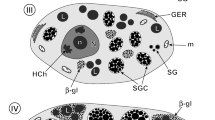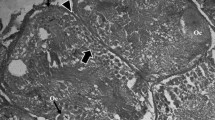Summary
1. In Microdalyellia fairchildi (Turbellaria, O. Neorhabdocoela) the occurrence of sclerotin precursors (phenolic substance, phenoloxidase, NH2-rich protein) is histo- and cytochemically tested.
2. In whole mount preparations, histological sections and isolated vitelline cells the three components could be demonstrated in special vesicles of the vitelline cells, which are present here along with nutrient vesicles. For other tissues and organs the tests were generally negative, especially for the so-called shell glands. After several corresponding results in many trematodes and in some cestodes the sclerotin nature of egg capsules seems now to be well-founded for a group of turbellaria too.
3. Tritium-labeled tyrosine, which is ingested with food, is markedly enriched in the vitellaria and shown to be an essential ingredient of the egg-shell material. But the idea that this tyrosine is the precursor of the phenolic substance and thus possibly participates in cross-linking the protein chains of sclerotin remains to be confirmed.
4. It is shown that the phenoloxidase of the vesicles catalyzes the oxidation of catechol but not that of Dopa (3,4-dihydroxyphenylalanine), a finding different from several biochemical investigations of the enzyme taken from other sources. Inhibition of the enzyme with some heavy metal complex-binding compounds (sodium diethyldithiocarbaminate, D-penicillamine) is demonstrated.
Zusammenfassung
1. An Microdalyellia fairchildi (Turbellaria, O. Neorhabdocoela) wird im Hinblick auf die chemische Natur der Eischalen das Vorkommen der Grundkomponenten des Sklerotins (Phenole, NH2-reiche Proteine, Phenoloxidase) histo- und cytochemisch überprüft.
2. An Totalpräparaten, histologischen Schnitten und isolierten Vitellocyten werden alle drei Komponenten in sogenannten Schalenvesikeln der Dotterzellen nachgewiesen, die hier neben anderen nährstoffhaltigen Vesikeln vorliegen. Für andere Gewebe und Organe, insbesondere die sogenannten Schalendrüsen, sind die ausgeführten Tests im wesentlichen negativ. Die Sklerotin-Natur der Eischalen ist damit nach entsprechenden Befunden an zahlreichen Trematoden und einigen Cestoden auch für eine Turbellarien-Gruppe erstmals erwiesen.
3. Die Verwendung von H3-Tyrosin zeigt eine beträchtliche Anreicherung dieser Aminosäure in den Vitellarien sowie eine starke Beteiligung am Aufbau der Eischalen. Die Vermutung, daß die Phenolkomponente aus Tyrosin hervorgeht und an der Brückenbildung der Proteinketten beteiligt ist, bleibt zu erweisen.
4. Bemerkenswert ist, daß sich die Aktivität der Phenoloxidase der Vesikel zwar auf Brenzcatechin, nicht aber auf Dopa (3,4-Dihydroxyphenylalanin) erstreckt; hierin weicht sie von den biochemischen Befunden extrahierter Phenoloxidasen verschiedener Herkunft ab. Mit verschiedenen Schwermetallkomplexbildnern (Natriumdiäthyldithiocarbaminat, D-Penicillamin) ist Inhibition möglich.
Similar content being viewed by others
Literatur
Adam, H., Czihak, G.: Arbeitsmethoden der makroskopischen und mikroskopischen Anatomie. Stuttgart: G. Fischer 1964.
Anderson, S.O.: Isolation of arterenone (2-amino-3′,4′-dihydroxyacetophenone) from hydrolysates of sclerotized insect cuticle. J. Insect Physiol. 16, 1951–1959 (1970).
Anderson, S.O.: Phenolic compounds isolated from insect hard cuticle and their relationship to sclerotization process. Insect Biochem. 1, 157–170 (1971).
Anderson, S.O., Barret, F.M.: The isolation of ketocatechols from insect cuticle and their possible rôle in sclerotization. J. Insect Physiol. 17, 69–83 (1971).
Brown, C.H.: Some structural proteins of Mytilus edulis. Quart. J. micr. Sci. 91, 331–339 (1952).
Burton, P.R.: A histochemical study of vitelline cells, egg capsules, and Mehlis' gland in the frog lung-fluke, Haematoloechus medioplexus. J. exp. Zool. 154, 247–257 (1963).
Clegg, J.A., Smyth, J.D.: Growth, development and culture methods: parasitic plathyhelminths. In: Chemical zoology, ed. M. Florkin and B.T. Scheer, vol. II, p. 395–466. N. Y., London: Academic Press 1968.
Duckworth, H.W., Coleman, J.E.: Physiochemical and kinetic properties of mushroom tyrosinase. J. biol. Chem. 245, No. 7, 1613–1625 (1970).
Johri, L.N., Smyth, J.D.: A histochemical approach to the study of helminth morphology. Parasitology 46, 107–116 (1956).
Karlson, P., Ammon, H.: Zum Tyrosinstoffwechsel der Insekten. XI. Biogenese und Schicksal der Acetylgruppe des N-acetyldopamins. Hoppe-Seylers Z. physiol. Chem. 330, 161–168 (1963).
Leuckart, K.G.F.R.: Die Parasiten des Menschen und die von ihnen herrührenden Krankheiten. Leipzig 1886 (2. Aufl.).
Lillie, R.D.: Histopathologic technic and practical histochemistry, (3. ed.) N. Y., London, etc.: McGraw-Hill Comp. 1965.
Luther, A.: Die Dalyellüden. Acta Zool. fennica 87, 1–337 (1955).
Mazia, D., Brewer, P., Alfert, M.: Cytochemical staining and measurement of protein mercuric bromophenol blue. Biol. Bull. 104, 57–67 (1953).
Mitchel, H.K., Weber, U.M.: Drosophila phenol oxidases. Science 148, 964–965 (1965).
Nurse, F.R.: Quinone tanning in the cocoon-shell of Dendrocoelum lacteum. Nature (Lond.) 165, 570 (1950).
Rainsford, K. D.: Zitiert aus J. A. Clegg u. J. D. Smyth (1968) (noch nicht publiziert).
Sekeris, C.E., Karlson, P.: Zum Tyrosinstoffwechsel der Insekten. VII. Der katabolische Abbau des Tyrosins und die Biogenese der Sklerotisierungssubstanz N-acetyldopamin. Biochem. biophys. Acta (Amst.) 62, 103–113 (1962).
Smyth, J.D.: A technique for the histochemical demonstration of polyphenol oxidase and its application to egg-shell formation in helminths and byssus formation in Mytilus. Quart. J. micr. Sci. 95, 139–152 (1954).
Smyth, J.D.: Studies on tapeworm physiology. IX. A histochemical study of egg-shell formation in Schistocephalus solidus (Pseudophyllidea). Exp. Parasit. 5, 519–540 (1956).
Smyth, J.D., Clegg, J.A.: Egg-shell formation in trematodes and cestodes. Exp. Parasit. 8, 286–323 (1959).
Spannhof, L.: Einführung in die Praxis der Histochemie, (2. Aufl.), Jena: VEB G. Fischer V., 1967.
Valcurone, M.: Ricerche istochimiche sui granuli vitellini dei Policladi. Arch. Zool. ital. 38, 245–268 (1953).
Vialli, M.: Ricerche istochimiche sui vitelligeni dei Platelminiti. Boll. Zool. 4, 135–138 (1933).
Vialli, M.: Ricerche istochimiche sui granuli vitellini dei policladi. Boll. Zool. 5, 21–23 (1934).
Wilson, R.A.: The structure and permeability of the shell and vitelline membrane of the egg of Fasciola hepatica. Parasitology 57, 47–58 (1967).
Author information
Authors and Affiliations
Rights and permissions
About this article
Cite this article
Bunke, D. Skerotin-Komponenten in den Vitellocyten von Microdalyellia fairchildi (Turbellaria). Z.Zellforsch 135, 383–398 (1972). https://doi.org/10.1007/BF00307183
Received:
Issue Date:
DOI: https://doi.org/10.1007/BF00307183




